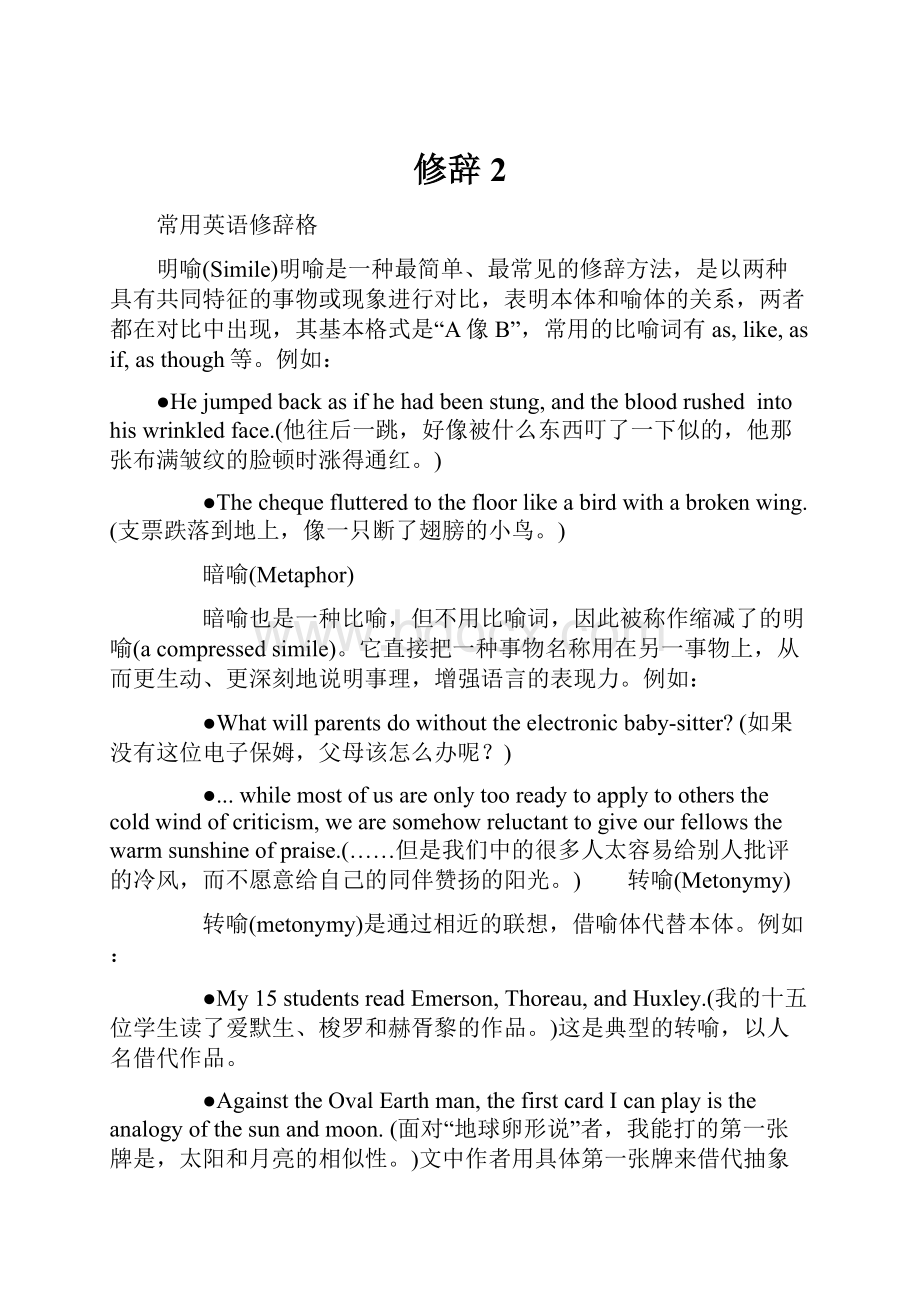修辞2.docx
《修辞2.docx》由会员分享,可在线阅读,更多相关《修辞2.docx(32页珍藏版)》请在冰豆网上搜索。

修辞2
常用英语修辞格
明喻(Simile)明喻是一种最简单、最常见的修辞方法,是以两种具有共同特征的事物或现象进行对比,表明本体和喻体的关系,两者都在对比中出现,其基本格式是“A像B”,常用的比喻词有as,like,asif,asthough等。
例如:
●Hejumpedbackasifhehadbeenstung,andthebloodrushed intohiswrinkledface.(他往后一跳,好像被什么东西叮了一下似的,他那张布满皱纹的脸顿时涨得通红。
)
●Thechequeflutteredtothefloorlikeabirdwithabrokenwing.(支票跌落到地上,像一只断了翅膀的小鸟。
)
暗喻(Metaphor)
暗喻也是一种比喻,但不用比喻词,因此被称作缩减了的明喻(acompressedsimile)。
它直接把一种事物名称用在另一事物上,从而更生动、更深刻地说明事理,增强语言的表现力。
例如:
●Whatwillparentsdowithouttheelectronicbaby-sitter?
(如果没有这位电子保姆,父母该怎么办呢?
)
●...whilemostofusareonlytooreadytoapplytoothersthecoldwindofcriticism,wearesomehowreluctanttogiveourfellowsthewarmsunshineofpraise.(……但是我们中的很多人太容易给别人批评的冷风,而不愿意给自己的同伴赞扬的阳光。
) 转喻(Metonymy)
转喻(metonymy)是通过相近的联想,借喻体代替本体。
例如:
●My15studentsreadEmerson,Thoreau,andHuxley.(我的十五位学生读了爱默生、梭罗和赫胥黎的作品。
)这是典型的转喻,以人名借代作品。
●AgainsttheOvalEarthman,thefirstcardIcanplayistheanalogyofthesunandmoon.(面对“地球卵形说”者,我能打的第一张牌是,太阳和月亮的相似性。
)文中作者用具体第一张牌来借代抽象的“第一个论据”,更加生动形象,浅显易懂,也使语言新鲜活泼,富有表现力。
拟人(Personification)
拟人是把人类的特点、特性加于外界事物上,使之人格化的修辞格。
例如:
●...fourevergreenshrubsstoodateachcorner,swherestheystruggledtosurvivethedustandfumesfromabusymainroad.(……四丛常绿灌木分别位于每个角落,它们忍受着从繁忙的大街上吹来的尘烟,挣扎着活下去。
)“挣扎”是有生命的物体的动作,作者给自然的花草赋予了生命,使它人格化。
●Butthehouseswerecold,closed,unfriendly.(可是那些房子冷漠无情,门窗紧闭,一点也不友好。
)house本来是没有感情的,作者通过拟人的手法,表现房子里人的冷漠无情。
夸张(Hyperbole)
夸张是一种故意言过其实,或夸大或缩小事物的形象,借以突出事物的某种特征或品格,鲜明地表达思想情感的修辞方式。
用于描写可以使形象更生动突出,渲染气氛,烘托意境,给读者留下深刻、鲜明的印象。
例如:
●Vingosatstunned,lookingattheoaktree.Itwascoveredwithyellowhandkerchiefs—20ofthem,30ofthem,maybehundreds.(文戈坐在那儿望着橡树惊呆了。
树上挂满了黄手绢——二十条,三十条,或许几百条。
)此句中20ofthem,30ofthem,maybehundreds就是运用了夸张的手法,主观地渲染了气氛。
●Shegavemetheimpressionofshavingsmoreteeth,whiteandlargeandeven,thanwerenecessaryforanypracticalpurpose.(她给我的印象是:
她有一口洁白整齐的大牙,为数之多已超过任何实际需要。
)在这里作者通过夸张的描述,使一个贪婪好吃的女性形象跃然纸上。
反语(Irony)
英语修辞格irony就是说反话,用反面的话来表达正面的意思。
这种修辞格可用来进行讽刺,但多数是用来表达一种善意的幽默或俏皮,故意说出与本意相反的话,例如:
●Slowlytheoldladystoopedtopickit(thecheque)up.Herpresent,herlovelypresent.Withtremblingfingersshetoreitsintoslittlebits.(老太太慢慢地弯下腰,把支票从地上捡起来,她的礼物,她的可爱的礼物!
用颤抖的手指把它撕得粉碎。
)老太太八十岁寿辰那天,急切地盼望女儿回家看望她,稍稍安慰她那颗孤寂的心,然而盼来的却是女儿的一张冷冰冰的支票,这当然不是老人心爱的礼物。
故此处herlovelypresent是典型的irony,是句反话。
●ShewasnotsoyoungasIexpectedandinappearanceimposingratherthanattractive.(她并不如我想象的那么年轻。
她的外表与其说吸引人,不如说是令人难忘。
)imposing意指因为外貌、形体而使人印象深刻,作者在此以讽刺挖苦的口吻来描述一个贪吃而肥胖的女人。
仿拟(Parody)
根据家喻户晓的成语或谚语,临时更换其中的某个部分,造成新的成语或谚语;或者根据古今名言警句,在保持其原句不变的情况下,更换其中部分词语,这种修辞方式叫仿拟。
例如:
●Tolieornottolie-thedoctor'sdilemma(撒谎还是不撒谎——医生的难题)看到这个标题,我们不禁想起莎翁戏剧Hamlet中那个永远也解不透的句子“Tobeornottobe,thatisthequestion”。
显然,文章的题目由此模仿而来,给人印象深刻。
●Ladyhermitswhoaredownbutnotout(穷困而不潦倒的女隐士们)文中的downbutnotout源于downandout,原是拳击比赛的术语,后来喻指穷困潦倒的人。
矛盾修辞法(Oxymoron)
用两种不相调和,甚至截然相反的特征来形容一项事物,在矛盾中寻求哲理,以便收到奇警的修辞效果,这就是矛盾修辞法,用这种方法,语言精炼简洁,富有哲理,并产生强大的逻辑力量,产生一种出人意料,引人入胜的效果。
例如:
●Amiserable,merryChristmas(悲喜交加的圣诞节)。
圣诞节那天,故事主人公小男孩经历了从痛苦的边缘到幸福的顶峰的过程。
因此,父母精心安排的圣诞节既是最糟的,又是最好的。
头韵(Alliteration)
与前面几种修辞方式不同,头韵是一种语音修辞方式,它指一组词、一句话或一行诗中重复出现开头字母相同的单词,常用于文章的标题、诗歌及广告语中,简明生动,起到突出重点,加深印象,平衡节奏,宣泄感情的作用。
例如:
●Amiserable,merryChristmas
●Profitsofpraise
1.生动形象的Simile(明喻)
2.含而不露的Metaphor(隐喻)
3.无灵有灵的Personification(拟人)
4.结构精巧的TransferredEpithet(移就)
5.蕴涵新意的Synecdoche(提喻)
6.明抑暗扬的Understatement(低调陈述)
7.闪烁其词的Euphemism(委婉)
8.强化语意的Hyperbole(夸张)
9.含蓄典雅的Allusion(引喻)
10.相映相衬的Antithesis(对照)
11.排迭匀称的Parallelism(平行)
12.发人深思的Paradox(隽语)
13.矛盾统一的Oxymoron(矛盾修饰)
14.妙趣横生的Anticlimax(突降)
15.一唱三叹的Repetition(重复)
16.音律优美的Alliteration(头韵)
17.一语两意的Pun(双关)
18.冷嘲热讽的Irony(反语)
19.趣味盎然的Parody(仿拟)
20.化腐为奇的Zeugma(轭式搭配)
英语修辞(EnglishRhetoric)
Figuresofspeech(修辞)arewaysofmakingourlanguagefigurative.Whenweusewordsinotherthantheirordinaryorliteralsensetolendforcetoanidea,toheighteneffect,ortocreatesuggestiveimagery,wearesaidtobespeakingorwritingfiguratively.Nowwearegoingtotalkaboutsomecommonformsoffiguresofspeech.
1)Simile:
(明喻)Itisafigureofspeechwhichmakesacomparisonbetweentwounlikeelementshavingatleastonequalityorcharacteristic(特性)incommon.Tomakethecomparison,wordslikeas,as...as,asifandlikeareusedtotransferthequalityweassociatewithonetotheother.Forexample,Ascoldwaterstoathirstysoul,soisgoodnewsfromafarcountry.
2)Metaphor:
(暗喻)Itislikeasimile,alsomakesacomparisonbetweentwounlikeelements,butunlikeasimile,thiscomparisonisimpliedratherthanstated.Forexample,theworldisastage.
3)Analogy:
(类比)Itisalsoaformofcomparison,butunlikesimileormetaphorwhichusuallyusescomparisonononepointofresemblance,analogydrawsaparallelbetweentwounlikethingsthathaveseveralcommonqualitiesorpointsofresemblance.
4)Personification:
(拟人)Itgiveshumanformoffeelingstoanimals,orlifeandpersonalattributes(赋予)toinanimate(无生命的)objects,ortoideasandabstractions(抽象).Forexample,thewindwhistledthroughthetrees.
5)Hyperbole:
(夸张)Itisthedeliberateuseofoverstatementorexaggerationtoachieveemphasis.Forinstance,healmostdiedlaughing.
6)Understatement:
(含蓄陈述)Itistheoppositeofhyperbole,oroverstatement.Itachievesitseffectofemphasizingafactbydeliberately(故意地)understatingit,impressingthelistenerorthereadermorebywhatismerelyimpliedorleftunsaidthanbybarestatement.Forinstance,Itisnolaughingmatter.
7)Euphemism:
(委婉)Itisthesubstitutionofanagreeableorinoffensive(无冒犯)expressionforonethatmayoffendorsuggestsomethingunpleasant.Forinstance,wereferto"die"as"passaway".
8)Metonymy(转喻)Itisafigureofspeechthathastodowiththesubstitutionofthemaneofonethingforthatofanother.Forinstance,thepen(words)ismightierthanthesword(forces).
9)Synecdoche(提喻)Itisinvolvesthesubstitutionofthepartforthewhole,orthewholeforthepart.Forinstance,theysaythere'sbreadandworkforall.Shewasdressedinsilks.
10)Antonomasia(换喻)Ithasalsotodowithsubstitution.Itisnotoftenmentionednow,thoughitisstillinfrequentuse.Forexample,Solomonforawiseman.Danielforawiseandfairjudge.Judasforatraitor.
11)Pun:
(双关语)Itisaplayonwords,orratheraplayontheformandmeaningofwords.Forinstance,acannon-balltookoffhislegs,sohelaiddownhisarms.(Here"arms"hastwomeanings:
aperson'sbody;weaponscarriedbyasoldier.)
12)Syllepsis:
(一语双叙)Ithastwoconnotations.
Inthefirstcase,itisafigurebywhichaword,oraparticularformorinflectionofaword,referstotwoormorewordsinthesamesentence,whileproperlyapplyingtooragreeingwithonlyonofthemingrammarorsyntax(句法).Forexample,Headdressedyouandme,anddesiredustofollowhim.(Hereusisusedtorefertoyouandme.)
Inthesecondcase,itawordmayrefertotwoormorewordsinthesamesentence.Forexample,whilehewasfighting,andlosinglimbandmind,anddying,othersstayedbehindtopursueeducationandcareer.(Heretolosingone'slimbsinliteral;toloseone'smindisfigurative,andmeanstogomad.)
13)Zeugma:
(轭式搭配)Itisasinglewordwhichismadetomodifyortogoverntwoormorewordsinthesamesentence,witherproperlyapplyinginsensetoonlyoneofthem,orapplyingtothemindifferentsenses.Forexample,Thesunshallnotburnyoubyday,northemoonbynight.(Herenoonisnotstrongenoughtoburn)
14)Irony:
(反语)Itisafigureofspeechthatachievesemphasisbysayingtheoppositeofwhatismeant,theintendedmeaningofthewordsbeingtheoppositeoftheirusualsense.Forinstance,wearelucky,whatyousaidmakesmefeelrealgood.
15)Innuendo:
(暗讽)Itisamildformofirony,hintinginaratherroundabout(曲折)wayatsomethingdisparaging(不一致)oruncomplimentary(不赞美)tothepersonorsubjectmentioned.Forexample,theweathermansaiditwouldbeworm.Hemusttakehisreadingsinabathroom.
16)Sarcasm:
(讽刺)Itisastrongformofirony.Itattacksinatauntingandbittermanner,anditsaimistodisparage,ridiculeandwoundthefeelingsofthesubjectattacked.Forexample,lawsarelikecobwebs,whichmaycatchsmallflies,butletwaspsbreakthrough.
17)Paradox:
(似非而是的隽语)Itisafigureofspeechconsistingofastatementorpropositionwhichonthefaceofitseemsself-contradictory,absurdorcontrarytoestablishedfactorpractice,butwhichonfurtherthinkingandstudymayprovetobetrue,well-founded,andeventocontainasuccinctpoint.Forexamplemorehaste,lessspeed.
18)Oxymoron:
(矛盾修饰)Itisacompressedparadox,formedbytheconjoining(结合)oftwocontrasting,contradictoryorincongruous(不协调)termsasinbitter-sweetmemories,orderlychaos(混乱)andproudhumility(侮辱).
19)Antithesis:
(对照)Itisthedeliberatearrangementofcontrastingwordsorideasinbalancedstructuralformstoachieveemphasis.Forexample,speechissilver;silenceisgolden.
20)Epigram:
(警句)Itstatesasimpletruthpithily(有利地)andpungently(强烈地).Itisusuallyterseandarousesinterestandsurprisebyitsdeepinsightintocertainaspectsofhumanbehaviororfeeling.Forinstance,Few,savethepoor,feelforthepoor.
21)Climax:
(渐进)ItisderivedfromtheGreekwordfor"ladder"andimpliestheprogressionofthoughtatauniformoralmostuniformrateofsignificanceorintensity,likethestepsofaladderascendingevenly.Forexample,Icame,Isaw,Iconquered.
22)Anti-climaxorbathos:
(突降)ItistheoppositeofClimax.Itinvolvesstatingone'sthoughtsinadescendingorderofsignificanceorintensity,fromstrongtoweak,fromwei